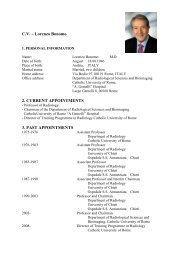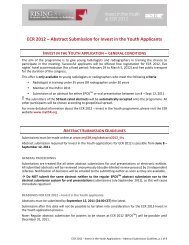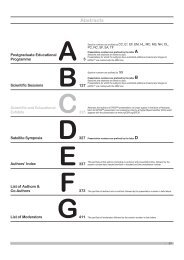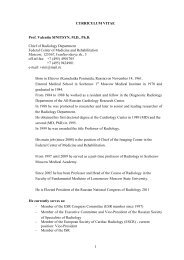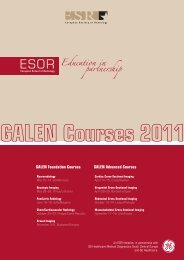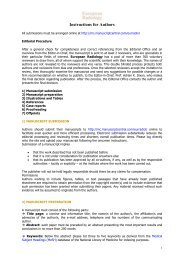Postgraduate Educational Programme - myESR.org
Postgraduate Educational Programme - myESR.org
Postgraduate Educational Programme - myESR.org
- No tags were found...
You also want an ePaper? Increase the reach of your titles
YUMPU automatically turns print PDFs into web optimized ePapers that Google loves.
<strong>Postgraduate</strong> <strong>Educational</strong> <strong>Programme</strong>negative findings may be encountered in case of “soft” lesions (mucinous, medullaryor cystic carcinomas) or inflammatory cancers. Differentiation between echogeniccysts and homogeneous solid lesions (such as fibroadenomas) can be improvedas cystic features are usually specific in elasticity imaging. Iso-echoic lesions suchas infiltrating lobular carcinomas may be better delimitated. Lymph-node characterisationand microcalcification assessment can be improved, although few dataare available and need further validation. 3D elastography is actually in progressand would be useful in monitoring response to neoadjuvant treatment.Learning Objectives:1. To understand the basic principles of US elastography.2. To learn about the difference between strain and shear wave elastographyand their respective results.3. To appreciate the additional value of US elastography to B-mode US.A-029 17:00C. MRI diffusion, perfusion and spectroscopyP.A.T. Baltzer; Vienna/ATDynamic contrast-enhanced MR-mammography is the most sensitive method fordetection of breast cancer. Diagnostic results using this technique may vary dueto reader experience as image interpretation is to some degree a subjective task.In the last years, further, more or less quantitative MRI techniques have been investigated.While pharmacokinetic modelling of high-temporal resolution dynamiccontrast-enhanced imaging (perfusion imaging) promises further, quantitativeinsights into the pathological characteristics of neoplastic vasculature, diffusionweightedimaging (DWI) and MR-spectroscopy (MRS) are based on entirely differentconcepts. While MRS is a molecular imaging technique able to quantify biochemicaltissue properties, DWI is influenced by microstructural tissue changes. This talkaims to outline the concepts of perfusion, DWI and MRS, provide knowledge toimplement these techniques into clinical practice and critically discusses the possiblediagnostic benefit of doing so.Learning Objectives:1. To understand the diagnostic value of diffusion weighted imaging (DWI) in itspresent clinical applications.2. To learn about the technical basics and potential use of MRI perfusion in thebreast.3. To understand promises and challenges of MR spectroscopy in clinical practice.16:00 - 17:30 Room G/HGenitourinaryRC 307Renal and adrenal tumoursModerator:B. Brkljacic; Zagreb/HRA-030 16:00A. Adrenal masses, a practical approachG. Heinz‐Peer; St. Pölten/AT (Gertraud.Heinz@stpoelten.lknoe.at)The increased use of imaging modalities has demonstrated the presence of varyingsized mass lesions in up to 5% of individuals subjected to CT studies for reasonsunrelated to adrenal dysfunction. When confronting an adrenal incidentaloma forwhich the diagnosis is not certain, one must address the adverse outcomes bywhich the patient can potentially be harmed: morbidity or mortality from hormonalexcess or cancer and the anxiety that comes from knowing about a tumour whichmight cause problems in the future. Most of these incidentally discovered lesionsare non-functioning benign lesions of cortical origin. However, incidentalomas mayalso represent functioning (clinical or subclinical) lesions arising from either thecortex or the medulla and malignant masses. Clinical diagnostic and biochemicalevaluation is used to further subdivide functional and non-functional adrenal lesions.CT and MR imaging are first choice in characterisation of adrenal lesions.Recently developed techniques of dual energy CT and histogram analysis may offeradditional information. The value of PET and PET/CT has already been proven.Other new functional imaging techniques, such as perfusion, diffusion-weightedimaging and MR-spectroscopy may play an important role in lesion characterisation.Most of adrenal masses can be characterised with accuracy of > 90% by usingthese techniques. Differentiating benign from malignant adrenal masses usingnon-invasive imaging methods can reduce the need both for percutaneous adrenalbiopsy in patients with underlying malignant disease and the follow‐up imaging ofincidentally detected adrenal adenomas.Learning Objectives:1. To become familiar with the different imaging appearances of adrenal massesincluding pathological relation.2. To learn the different imaging techniques to improve evaluation of benignversus malignant adrenal masses.3. To understand the impact of imaging given the information that the patienthas/has not a known malignancy.A-031 16:30B. Staging renal cancerR. Pozzi‐Mucelli; Verona/ITThe diagnosis of renal cell carcinoma (RCC) by means of imaging modalitiesinclude the identification of the lesion, its characterisation, the staging and thefollow‐up. Staging is an important part of the diagnostic process since it has directeffect on the therapeutical decision. In the case of renal tumour, staging is basedon the TNM (AJCC Cancer Staging system) which has replaced other stagingclassifications such as the Robson classification. Based on the TNM classification,two main types of renal tumours can be defined, the localised RCC (T1-T2)and the locally advanced RCC (T3-T4). In the case of T1 and T2 RCC, the mostimportant parameter is tumour size: the cut point is 7 cm which separates T1 fromT2 tumours. T1 tumours are further divided into T1a and T1b if less than 4 cm orbetween 4 and 7 cm, respectively. This further division has impact on type of surgery,i.e. partial versus radical nephrectomy. In the case of T3 and T4 RCC, differentfeatures should be carefully evaluated: these include the perirenal fat invasion, thedirect infiltration of the ipsilateral adrenal gland, the infiltration of renal sinus fat, thevena cava and renal vein thrombosis, the urinary collecting system invasion andmetastatic disease to local lymphonodes and other <strong>org</strong>ans. CT still represents themethod of choice for the staging of renal tumours since, also by using MPR andVR images, it gives all the information for the local and distant evaluation. MRI cansupport CT in complex cases.Learning Objectives:1. To recognise the CT/MRI/US findings for staging.2. To learn about the optimal imaging protocol for the diagnosis and staging ofrenal cancer.3. To understand treatment options and implications.A-032 17:00C. How to deal with small indeterminate renal massesO. Hélénon; Paris/FR (olivier.helenon@nck.aphp.fr)Renal masses include three categories with respect to the size and the grossarchitecture of the lesion: indeterminate very small masses, cystic and solid renalmasses. Very small lesions (< 10 mm) usually remain unclassified because ofpartial volume effect that prevents accurate CT attenuation measurement. With theexception of patients at risk of renal neoplasms such as familial-hereditary renaltumour disease and patients with history of removed carcinoma, such lesions arelikely to be microcysts and do not require further workup. If better characterisationis needed, MRI using T2 and Diffusion-Weighted imaging or contrast-enhancedUS may help differentiate very small cysts from solid neoplasms. Characterisationof small cystic masses relies on the Bosniak's classification which consists of 5categories: benign (I) and minimally complicated (II) cysts, indeterminate cysticlesions (IIF and III) and malignant cystic masses (IV). Certain cases of cysticmasses remain not categorisable at CT because of their proper atypical attenuationcharacteristics or enhancement properties. US and MRI play a major role by providinguseful additional diagnostic information that help distinguish between atypicalfluid fill masses and atypical solid neoplasms especially solid papillary RCC withpoor vascularity. The goal of imaging in characterising small solid renal tumours isto differentiate typical angiomyolipoma containing macroscopic fat from non-fattyindeterminate renal neoploasms that should be removed. Percutaneous-guidedbiopsy is performed when accurate characterisation is needed before surgery orwhen renal metastases or lymphoma are suspected.Learning Objectives:1. To become familiar with the various appearances of small indeterminate renalmasses.2. To learn about the respective roles of US, CT and MR imaging in investigatingsmall renal masses.3. To learn the main pitfalls in assessing small renal masses.S12AB C D E F G




